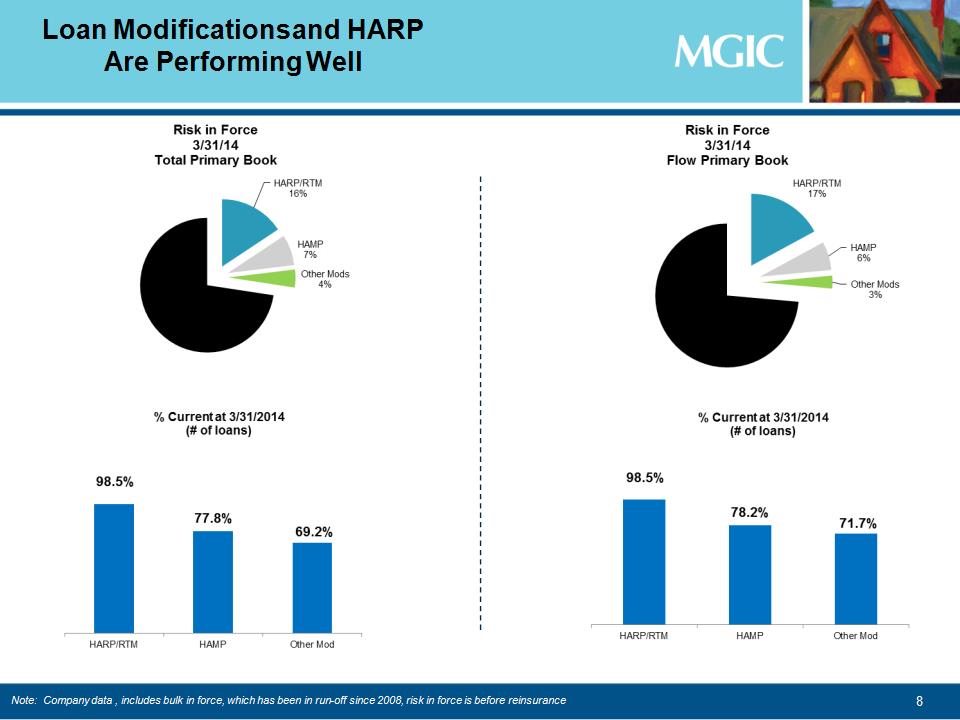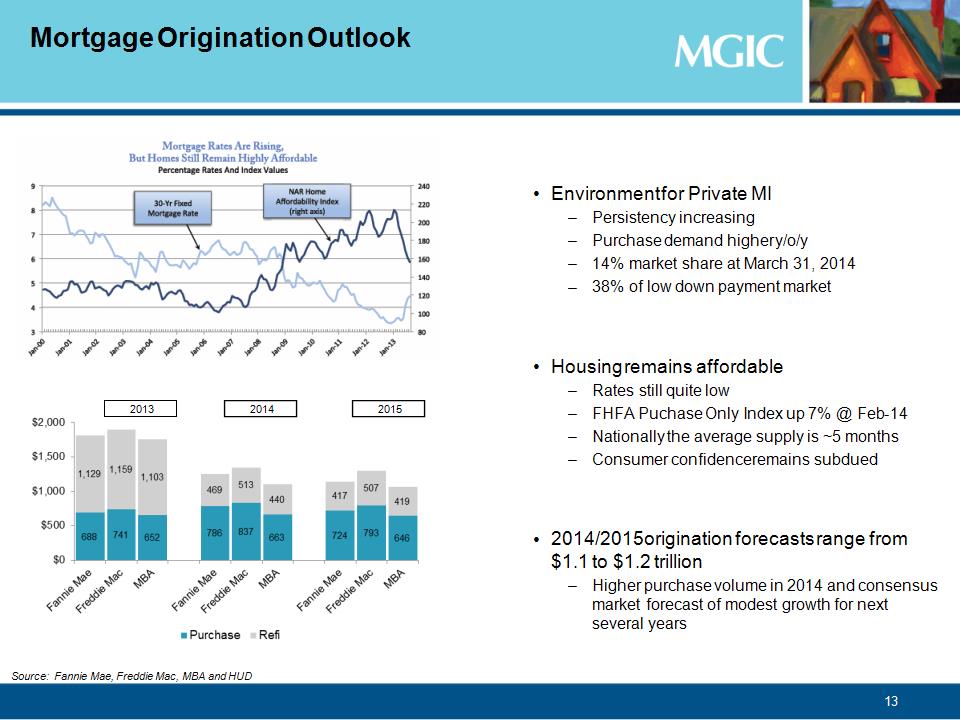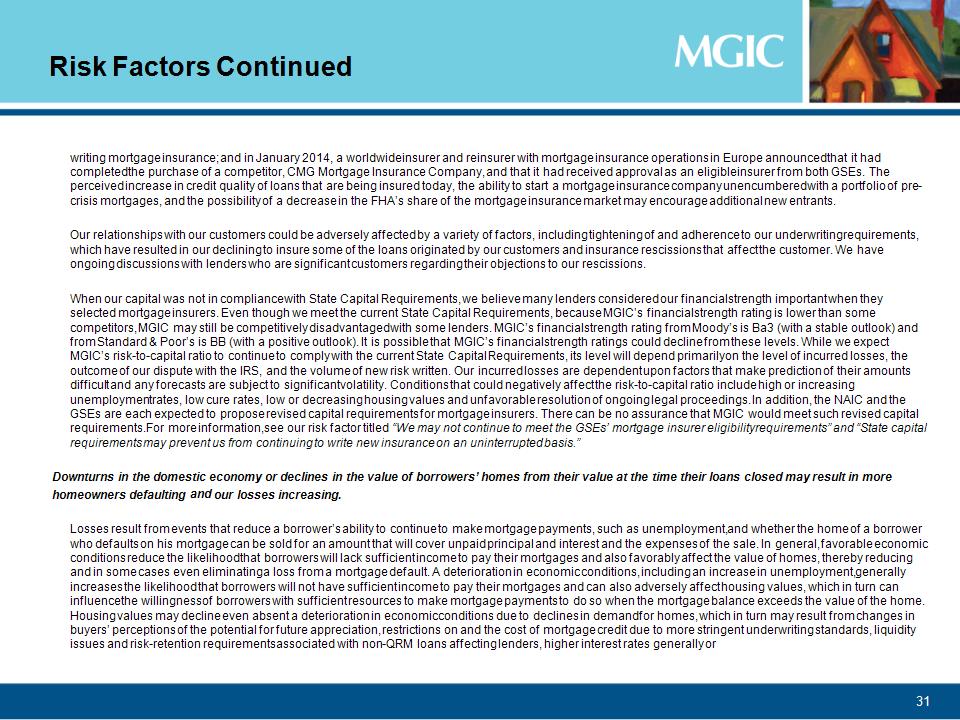mitigate our loss by performing reasonable loss mitigation efforts or, for example, diligently pursuing a foreclosure or bankruptcy relief in a timely manner. We call such reduction of claims submitted to us “curtailments.” In 2013 and the first quarter of 2014, curtailments reduced our average claim paid by approximately 5.8% and 5.9%, respectively. In addition, the claims submitted to us sometimes include costs and expenses not covered by our insurance policies, such as hazard insurance premiums for periods after the claim date and losses resulting from property damage that has not been repaired. These other adjustments reduced claim amounts by less than the amount of curtailments. After we pay a claim, servicers and insureds sometimes object to our curtailments and other adjustments. We review these objections if they are sent to us within 90 days after the claim was paid. When reviewing the loan file associated with a claim, we may determine that we have the right to rescind coverage on the loan. Prior to 2008, rescissions of coverage on loans were not a material portion of our claims resolved during a year. However, beginning in 2008, our rescissions of coverage on loans have materially mitigated our paid losses. In 2009 through 2011, rescissions mitigated our paid losses in the aggregate by approximately $3.0 billion; and in 2012, 2013 and the first quarter of 2014, rescissions mitigated our paid losses by approximately $0.3 billion, $135 million and $26 million, respectively (in each case, the figure includes amounts that would have either resulted in a claim payment or been charged to a deductible under a bulk or pool policy, and may have been charged to a captive reinsurer). In recent quarters, approximately 5% of claims received in a quarter have been resolved by rescissions, down from the peak of approximately 28% in the first half of 2009. We estimate rescissions mitigated our incurred losses by approximately $2.5 billion in 2009 and $0.2 billion in 2010. These figures include the benefit of claims not paid in the period as well as the impact of changes in our estimated expected rescission activity on our loss reserves in the period. In 2012, we estimate that our rescission benefit in loss reserves was reduced by $0.2 billion due to probable rescission settlement agreements. We estimate that other rescissions had no significant impact on our losses incurred in 2011 through the first quarter of 2014. At March 31, 2014, we estimate that our total loss reserves were benefited from anticipated rescissions by approximately $70 million. Our loss reserving methodology incorporates our estimates of future rescissions and reversals of rescissions. Historically, reversals of rescissions have been immaterial. A variance between ultimate actual rescission and reversal rates and our estimates, as a result of the outcome of litigation, settlements or other factors, could materially affect our losses. If the insured disputes our right to rescind coverage, we generally engage in discussions in an attempt to settle the dispute. As part of those discussions, we may voluntarily suspend rescissions we believe may be part of a settlement. In 2011, Freddie Mac advised its servicers that they must obtain its prior approval for rescission settlements, Fannie Mae advised its servicers that they are prohibited from entering into such settlements and Fannie Mae notified us that we must obtain its prior approval to enter into certain settlements. Since those announcements, the GSEs have consented to our settlement agreements with two customers, one of which is Countrywide, as discussed below, and have rejected other settlement agreements. We have reached and implemented settlement agreements that do not require GSE approval, but they have not been material in the aggregate. If we are unable to reach a settlement, the outcome of a dispute ultimately would be determined by legal proceedings. Under our policies, legal proceedings disputing our right to rescind coverage may be brought up to three years after the lender has obtained title to the property (typically through a foreclosure) or the property was sold in a sale that we approved, whichever is applicable, although in a few jurisdictions there is a longer time to bring such an action. As of March 31, 2014, the period in * Risk Factors Continued





































